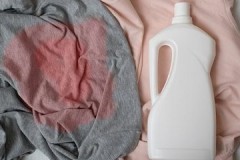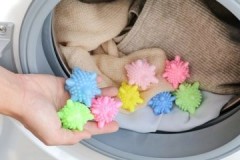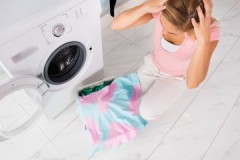Operation Antifat, or how to remove a greasy stain on clothes
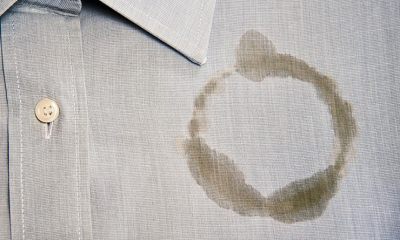 Greasy stains on clothing can be divided into 2 categories: fresh and old. It is difficult to get rid of them effectively.
Greasy stains on clothing can be divided into 2 categories: fresh and old. It is difficult to get rid of them effectively.
And if fresh ones can be removed using available tools, then special cleaning agents will be required to combat old stains.
And in some cases, getting rid of them at home is generally impossible, and you have to go to dry cleaning.
Is it possible and how to remove a greasy stain on clothes (fresh or old) at home, we will tell in the article.
Content
- The main differences between fresh and old pollution
- Preparatory stage
- How can you remove the newly planted at home?
- How to remove old stains at home?
- Removal from different types of tissues
- What is the difference between washing white and colored fabric?
- What if the item has already been washed?
- Useful video
- Finally
The main differences between fresh and old pollution
The main difference between the two is how much the fat is absorbed into the tissue.... If the stain has been planted relatively recently, it will be much easier to remove. Many tools that can be found in the house of any housewife will help get rid of it.
With the outdated, the situation is much more complicated. Since the fat is already well absorbed into the fibers of the fabric, simple methods are likely to fail to clean it. This will require resorting to stronger and more expensive cleaning agents.
Preparatory stage
Before cleaning, you need to remember a few simple rules and prepare the materials necessary for this:
-
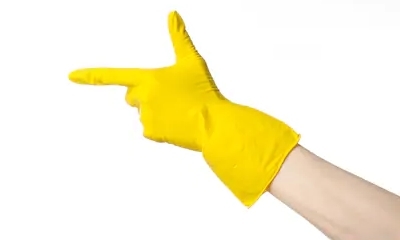 First of all, carefully study the label from the manufacturer. There you can find recommendations on the choice of detergent, washing mode and water temperature.
First of all, carefully study the label from the manufacturer. There you can find recommendations on the choice of detergent, washing mode and water temperature.Do not neglect this rule, as this significantly increases the chances of not ruining your clothes when washing.
- Prepare the necessary materials: cotton cloth or paper, a soft brush, a cotton pad or piece of clean cloth, clean water and materials for the solution.
- Using a soft brush, you need to clean clothes from foreign objects: dust, wool, dirt, etc.
- When diluting the solution, use the weakest concentration, if there is no effect, then gradually increase it.
- Be sure to turn the thing inside out. Place a cotton towel or paper under the stain, having previously folded it in several layers, and only then proceed to cleaning.
Before you start cleaning, you need to test the solution on an inconspicuous area of the thing or a test piece of cloth, if any. This procedure will greatly increase the chances of not ruining the item.
How can you remove the newly planted at home?
If the planted spot is still fresh, it will be much easier to get rid of it than from the old one. This can be done at home, using both improvised means and chemicals.
-
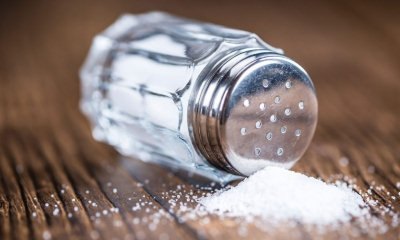 Salt. Regular table salt will do. You need to sprinkle it on the stain and use a sponge to gently rub into the fabric. Then leave for a while so that it absorbs all the fat.
Salt. Regular table salt will do. You need to sprinkle it on the stain and use a sponge to gently rub into the fabric. Then leave for a while so that it absorbs all the fat.Then, using a soft brush, shake off the remains, if it was not possible to remove the stain the first time, the procedure is repeated.
- A piece of chalk. This method is similar to the previous one, the only difference is the algorithm of use.
Chalk does not need to be rubbed into clothes like salt, you just need to sprinkle stains on top and wait one hour. Use a damp cloth to remove any traces of chalk.
- Potato starch... The method is similar to the previous one. The difference is that you need to wait less, just 15 minutes is enough. Then the starch layer must be removed with a brush.
- Bread crumb... It perfectly absorbs greasy stains. It is necessary to attach it to the contaminated area and wait until the fat is absorbed, then wash the thing in the washing machine.
- Mustard powder... Mix water and powder, the consistency of the mixture should be like porridge. Apply it on the stain and let it sit for 30 minutes, then gently scrub with a soft brush.
- Dish detergent... It is better to choose trusted manufacturers and not use a cheap product. Fairy is a good choice. It copes equally well with all types of dirt, an important condition for them to be fresh.
This method does not require preliminary preparations, just apply a little product to the contaminated area and use a cotton pad to rub it well into the fabric until foam forms. Soak 15 minutes and wash in warm water.
- Shampoo for oily hair... This method is completely similar to the previous one. The algorithm of actions looks the same.
- Laundry soap... It is considered a universal remedy for all types of stains. The contaminated area must be well soaped and rubbed with a soft sponge or cotton pad from edge to center. Then leave for half an hour and wash in the washing machine. To improve the effect, you can also sprinkle sugar on top of the stain, but this method is not suitable for delicate fabrics.
- Shaving foam... Regular shaving foam works well against fresh grease stains. Apply a layer of foam evenly over the entire contaminated area and let sit for 20 minutes. Then wash the item in warm water.
- Alcohol. Both ammonia and ethyl are suitable. Works well on all types of fresh stains, but not on delicate fabrics. The stain should be well moistened with alcohol and left for one hour, then washed in warm water.
How to remove old stains at home?
Old traces are much more difficult to remove, but this is possible both with the help of improvised means and chemicals.
- Brine... Add a glass of salt to a bowl of water and stir well. Soak your clothes in this solution for 3 hours, then wash as usual.
-
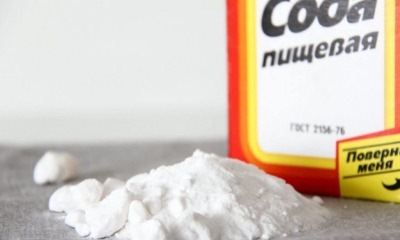 Vinegar. It will help you get rid of the juice of berries and herbs. Moisten a cotton ball with vinegar, then treat the stain with it and rinse in cold water.
Vinegar. It will help you get rid of the juice of berries and herbs. Moisten a cotton ball with vinegar, then treat the stain with it and rinse in cold water.After rinsing, you need to sprinkle the stain with salt, it will absorb the residue and prevent the stain from blurring.
- Soda. Will get rid of sweat marks. Mix baking soda (2 tablespoons), dishwashing detergent (1 tablespoon), and hydrogen peroxide (4 tablespoons). Apply it on the stain, wait 5 minutes and wash off with cold water.
- Turpentine. Mix turpentine and ammonia in proportions 1: 1. Apply to stain, wait an hour and machine wash.
- Dentifrice... It is necessary to apply the tooth powder to the entire surface of the stain and allow it to absorb. Then send the item to the washing machine.
- Refined gasoline... Gasoline is able to clean any contamination. To do this, apply gasoline to a cotton pad or piece of cloth and wipe the area thoroughly. After that, it remains to wash the thing in the usual way.
- Gasoline and starch... It is necessary to mix them until they become thick sour cream and apply to the stain. Use a sponge or cotton pad to wipe the area well, rinse with warm water and wash in the washing machine.
- Glycerol. Apply a few drops to the stain and spread with a cloth or cotton pad over the entire surface. Leave it on for 30 minutes. Then, using a cloth that absorbs moisture well, a sponge or a cotton pad, remove the residue and wash as usual.
- Ammonia. It will help to cope with stains from coffee, chocolate, sweat. Mix water and rubbing alcohol in a 2: 1 ratio, apply on the stain and wait 30 minutes. Then wash the item in warm water.
- Hydrogen peroxide... It will help get rid of stains of coffee, tea, hair dye. Apply to the soiled area of the cloth, wipe with a soft sponge and leave for 15 minutes. Then remove the remaining dirt and wash in the washing machine.
Removal from different types of tissues
Some products work better on certain types of tissue. Next, consider which means are best used for products from:
-
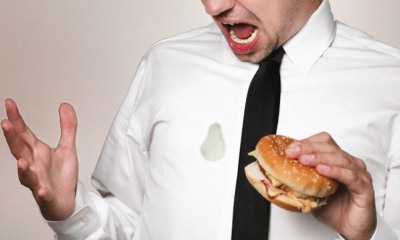 Cotton. Ordinary gasoline helps to get rid of greasy marks on cotton clothes. The product is very aggressive, so you need to use it in small proportions.
Cotton. Ordinary gasoline helps to get rid of greasy marks on cotton clothes. The product is very aggressive, so you need to use it in small proportions.It is best to lightly dampen the soiled area of the cloth, place a paper towel under the stain, and wait until the gasoline is absorbed.
- Calico. On chintz clothes, a solution of ammonia and water in a ratio of 1 to 2 will effectively get rid of a greasy stain.
- Synthetics. Dirt on synthetic items can be easily removed with ammonia. To do this, you need to make a solution: 1 teaspoon of ammonia in a glass of water, mix well and gently apply to the contaminated area. After that, send the item to an ironing board, cover with a cotton cloth and iron with an iron.
- Plush. Turpentine will help get rid of the greasy mark on plush clothes.
- Atlas. Greasy stains from satin fabrics can be removed with a clear detergent. To do this, gently apply a small amount of the product to the stain and rub with a damp cotton pad until foam forms. After that, just rinse in warm water, if the result is not satisfactory, repeat the procedure.
- Velvet. To remove stains from velvet clothes, ordinary bread crumb will help. It must be pressed against the soiled area of the fabric and held for some time, allowing the fat to be absorbed. Then send the item to the washing machine, the stain will disappear.
- Knitwear. You can remove the dirt on the knitwear with soap and sugar. You need to wet the stain with hot water, soap well and sprinkle with sugar. Using a brush, rub the contaminated area for a few minutes, then leave for half an hour. Then it remains only to wash the thing in the normal mode of the washing machine.
- Silks. Silk is considered a delicate fabric, so be careful when removing stains from silk items. A solution of glycerin, water and ammonia in proportions of 1: 1: 1 will help well in this.
- Polyester. The way to remove greasy marks from this type of fabric is simple. Apply potato starch to the stain, place a cotton towel on top and iron with an iron. The procedure must be repeated until the stain disappears, while adding starch.
- Wool. Woollens can be removed from greasy stains with refined gasoline.Lightly dampen a cotton pad, and gradually moving from edge to center of the stain, rub the product over the entire area of contamination.
In order not to spoil the thing, first check the action of the selected product on an inconspicuous area of the fabric.
What is the difference between washing white and colored fabric?
Wash white and black things significantly different from washing colored items. Many folk remedies are ideal for white and black clothes.
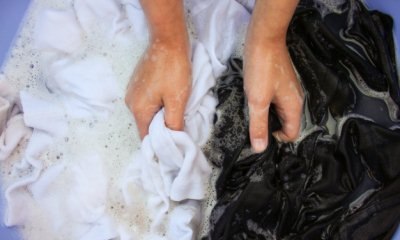 For example, to remove dirt on a white cloth, you can use:
For example, to remove dirt on a white cloth, you can use:
- baby powder
- talc,
- laundry soap,
- ammonia,
- brine.
They also use the steaming method using tracing paper.
Dirt on black clothes can be soaked in CocaCola or Pepsiand then send it to the washing machine. Mustard powder is also used, diluting it with water to a state of porridge and rubbing it into a greasy spot.
The situation with colored clothing is somewhat more complicated. The fact is that, unlike white and black clothes, it can lose its color, especially if aggressive chemicals are used. It may happen that when trying to clean off a greasy stain, a separate area of the fabric may become more faded.
It has a high price tag, but the line contains many products for different types of fabrics. Using this tool will safely remove greasy stains without losing the color quality of the thing.
From folk remedies, you can answer a solution of their water, salt and ammonia... Dilute the solution in proportions 1: 1: 1. This will effectively remove oil and grease stains without damaging the fabric.
What if the item has already been washed?
 After a stain has been planted on clothes, it is highly discouraged to immediately throw it into the washing machine.
After a stain has been planted on clothes, it is highly discouraged to immediately throw it into the washing machine.
In most cases, this will not help get rid of the stain, but will only aggravate the situation, it not only does not wash off, but also spreads over a larger area of the product.
If it happened that the thing was washed, it's okay, this can be fixed... First of all, you can use one of the presented methods for removing old stains.
Before that, you need to pay attention to the type of fabric and choose the appropriate method so as not to aggravate the situation even more.
If the item is expensive, it is better not to risk it at all, but to go to a dry cleaner... It is equipped with professional equipment to remove all kinds of stains. It will cost a little more than cleaning at home, but the result is guaranteed to be positive.
Useful video
How to remove a greasy stain from clothes, video recipes:
Finally
Although at first glance it seems that the procedure for removing a grease stain is very difficult, it is not. There are many ways to get rid of pollution at home. using improvised means.
We examined most of them in detail in the article. The main thing is to follow simple rules and pay attention to the type of fabric so that the chosen method does not harm the thing.

